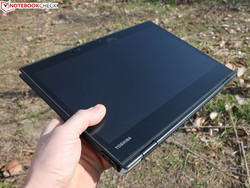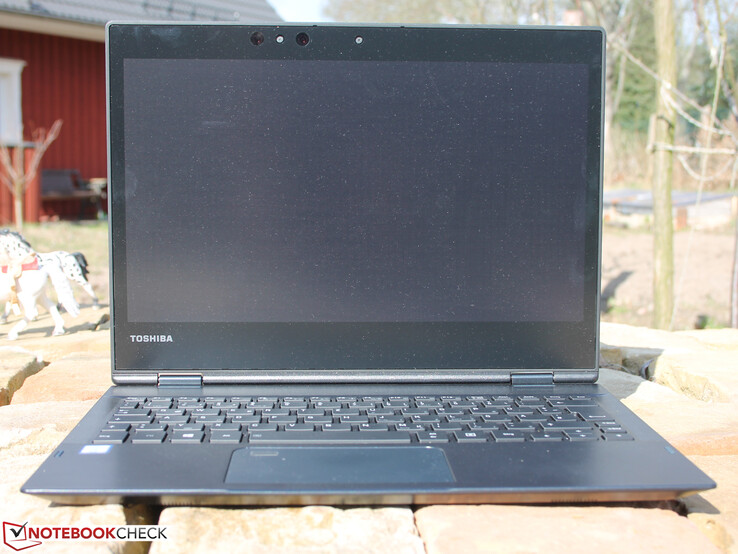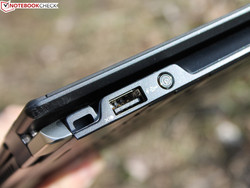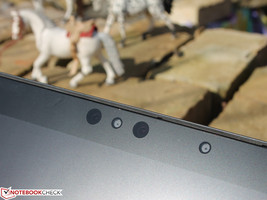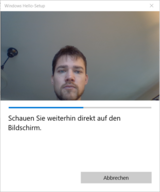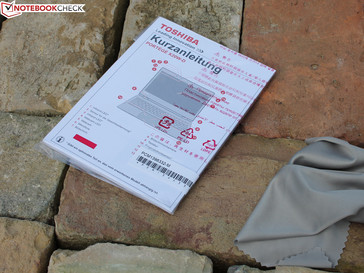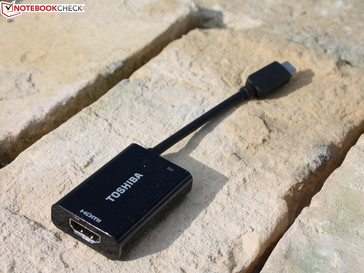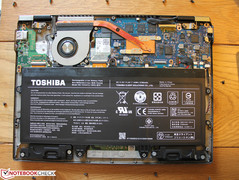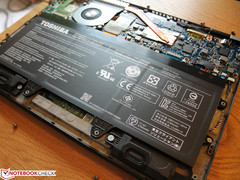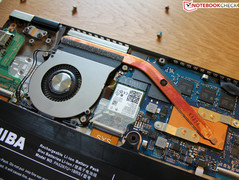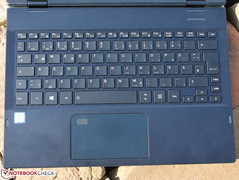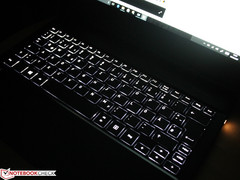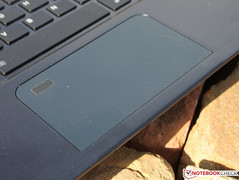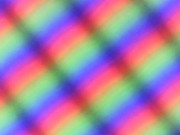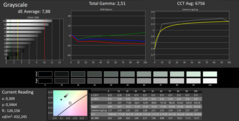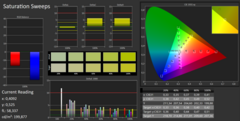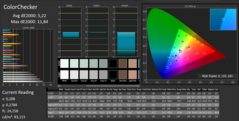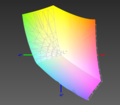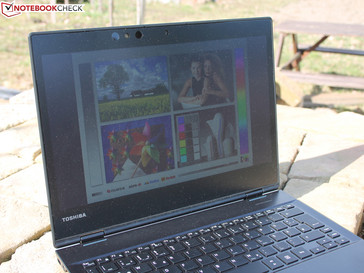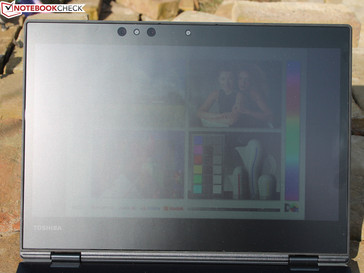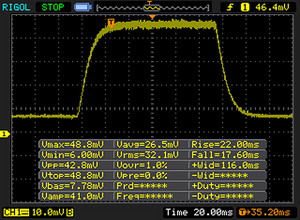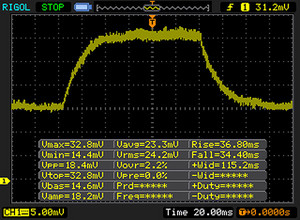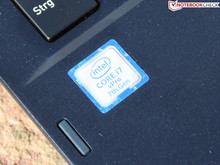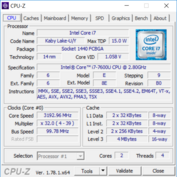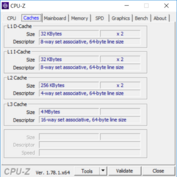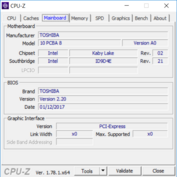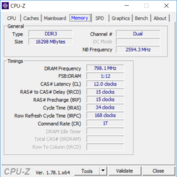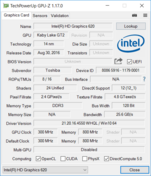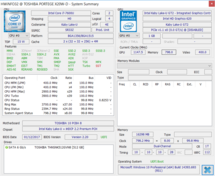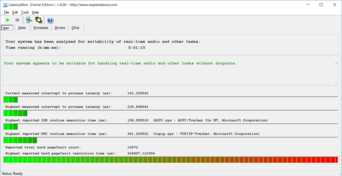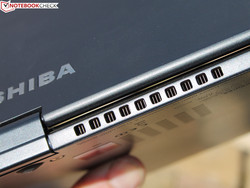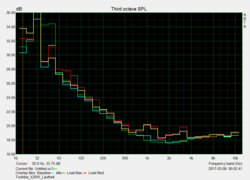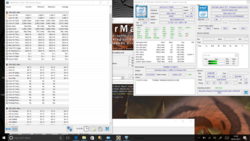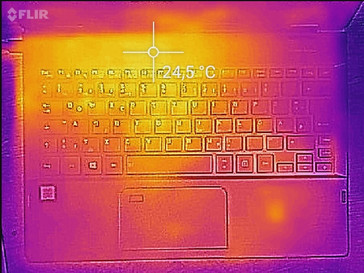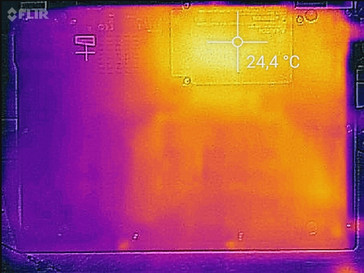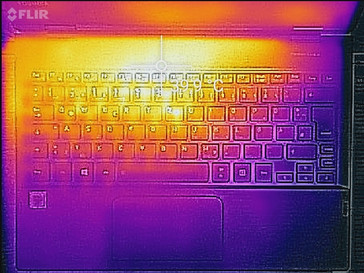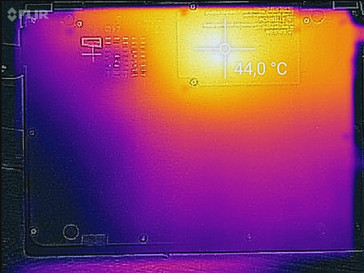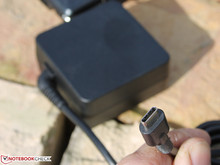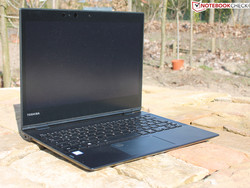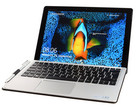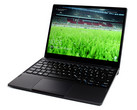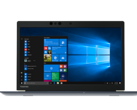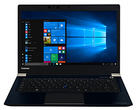Toshiba Portégé X20W (7600U, 512 GB) Convertible Review

For the original German review, see here.
Ultra-thin, extremely light, an outstanding battery life of up to 16 hours, and ready for cutting-edge input devices, such as Wacom's TruPen and Windows Ink sketch pad. As a 12.5-inch device, the Portégé X20w also promises nothing less than the full Core i performance of a subnotebook with active cooling - consequently, no throttling during permanent load.
This all sounds a bit like a jack-of-all-trades especially since some well-known manufacturers have found the throttling issue a hard nut to crack. The chassis of the X20w has a height of just 15.4 millimeters; 9 millimeters of this belongs to the base. An efficient cooling system in a 9-millimeter casing? HP's Spectre 13 was the last to try and fail here.
Can Toshiba's Portégé X20w fully utilize its Turbo, and keep the promise of mobility and useful ergonomics? Our in-depth report provides the answer.
The rivals are not only found in the 360-degree sector. Tablets with a folio keyboard dock now also have computing power that equals, believing the promise, that of a subnotebook.
- Lenovo ThinkPad Yoga 260 20FD001XGE (12.5-inch, i7-6500U)
- Microsoft Surface Pro 4 (12.3-inch, Core i5/i7)
- Acer Aspire Switch Alpha 12 SA5-271-56HM (12-inch, i5-6200U)
- Lenovo Miix 720 (12-inch, i7-7500U)
- Asus Transformer 3 Pro T303UA (12.6-inch, i7-6500U)
Case
According to Toshiba, the Portégé x20w is the slimmest 2-in-1 device with the latest Intel Core processors up to Core i7. 1024 grams confirms the 12.5-inch device's astonishingly low weight. This is even lower than convertibles with a folio-keyboard dock not to mention among all similarly sized 360-degree rivals. Acer's Aspire Switch 12 Alpha (12-inches; 1.29 kg) is heavier just like HP's Elite x2 1012 G1 (12.1-inches; 1.2 kg). Microsoft's Surface Pro 4 (12.3-inches; 1.1 kg) weighs more.
Toshiba achieves this flyweight by waiving on aluminum and using a magnesium alloy. The matte surfaces imitate brushed aluminum and have a cool metal-like feel. The construction's torsional stiffness is amazingly good especially that of the base. The lid is not rock-solid but sooner flexible. It dents when pressure is applied to the back. The cavities under the wrist rest are not nice; a cracking noise is even produced when pressed on the left. Otherwise, the material transitions and burrs are exemplary.
The hinge is solid metal, but it is not pulled as firmly as it could be: When we shake the X20w, the display falls back autonomously. Nevertheless, the manufacturer has successfully managed to make the hinge's tension homogeneous: Opening it is easy at first, then more difficult up to laptop mode, then even more difficult until tent mode (the display does not fall over even when shook here), and finally the tension becomes very soft before falling magnetically into the end position.
The hinge's design causes a big gap of 2 mm between the display and base in tablet mode. However, this is intentional as it prevents the vents from being covered.
Connectivity
Toshiba does not leave anything out in terms of interfaces: Thunderbolt 3 is simply a must for such a premium device. Like Thunderbolt 3, the USB 3.1 Type-C Gen.2 port supports data sharing, recharging, and DisplayPort.
Only two interfaces follow the combo-headphone jack on the opposite side: USB 3.1 Type-C Gen.2 (10 Gbps support) and a USB 3.0 Type-A port (sleep and charge USB). Toshiba allowed the chassis to be thicker for the ports here.
Communication
Intel's Dual-Band Wireless-AC 8265 incl. Bluetooth 4.2 does an impeccable job without any issues. At a transmit speed of 663 MBit/s, the Wi-Fi chip is very good in the test field. On the other hand, the rivals are good, too. It can only be said that these rates are sooner the normal case for premium-range laptops.
| Networking | |
| iperf3 transmit AX12 | |
| Asus Transformer 3 Pro T303UA-GN050T | |
| Toshiba Portege X20W-D-10R | |
| Lenovo Ideapad Miix 720-12IKB | |
| Microsoft Surface Pro 4, Core i5, 128GB (Klaus I211) | |
| iperf3 receive AX12 | |
| Asus Transformer 3 Pro T303UA-GN050T | |
| Lenovo Ideapad Miix 720-12IKB | |
| Toshiba Portege X20W-D-10R | |
| Microsoft Surface Pro 4, Core i5, 128GB (Klaus I211) | |
Security
Except for SmartCard, all tools for connecting and using the X20W in companies are installed. This includes a Trusted Platform Module 2.0 for making encryption and log-in options more secure. Beyond that, the X20w-D features its own BIOS, Intel's Active Management, Microsoft's Management Instrumentation Interface, and Toshiba's System Center Configuration Manager in terms of hardware and software.
A fingerprint scanner, IR camera for Windows Hello and a cable-lock slot are also present.
The touchpad-integrated fingerprint scanner (SecurePad) and facial recognition via the IR camera (Intel Authenticate Support) are convenient options to make log-ins and log-outs more tolerable. We tested them successfully.
Accessories and Software
An AES stylus pen, the USB Type-C power supply, and a USB-C-to-HDMI adapter are in the box. Microsoft Office 365 (1-month trial) and Toshiba's Eco Utility are preloaded.
The manufacturer also wanted to present a matching Thunderbolt 3 dock at sales launch (Toshiba PA5281E-1PRP). This would add several interfaces, such as HDMI, DisplayPort, VGA, and Ethernet. However, the dock was not yet available at publishing time, although the price was listed: 300 Euros (~$324).
Mobile users might be interested in the USB C Travel Dock that also adds HDMI, VGA, LAN, and USB 3.0 ports. Both docks also supply power. Furthermore, a special protective bag with a pen-holder is offered for the Portégé X20w-D.
Maintenance
Warranty
The manufacturer includes a 1-year Reliability Warranty, which means repair + refund in case of warranty. That's right:
If the device breaks down within one year of purchase, the customer will receive a full refund plus the laptop will be repaired and returned free of charge. The device only has to be registered within 30 days of purchase.
Beyond that, the manufacturer's European bring-in warranty including an on-site pick-up service in Germany and Austria applies (repair must be registered via Toshiba's laptop hotline).
Please see our Guarantees, Return Policies and Warranties FAQ for country-specific information.
Input Devices
Keyboard
The input devices of the X20w do not really fit to the price category of beyond 1500 Euros (~$1622) in the tester's opinion. Not that typing involves an awkward feeling: The keys have a firm stroke that is neither too loud nor too hard. The concave letter keys allow the fingers to find them easily. Unfortunately, the keys are relatively small in this layout. The manufacturer favored a wider spacing here. We find the opposite in the Miix 720: big keys and narrower gaps.
The slightly undefined pressure point and short drop prevents typing from being fun. We also often hit a neighboring key due to the small size, e.g. the shift or arrow keys seen in the screenshot. Toshiba would have been well advised to use the chassis' entire width. It is even easier and more comfortable to type on the folio-keyboard of the Miix 720 that we are also currently testing.
Touchpad
The ClickPad without dedicated mouse keys has a diagonal of 11.1 centimeters. Thus, it is a bit bigger than that of the Miix. The surface is roughened and the finger makes a grinding noise when gliding over it. The accuracy is without reproach, but the drop is very short already in the lower part of the rocker. The pressure point is short so that fast clicking is possible. However, good feedback looks different.
The touch-fingerprint scanner is incorporated into the pad. It functioned reliably with Windows Hello.
Touchscreen
The matte screen is a special feature at Toshiba. The manufacturer already has a tradition with matte touch-surfaces in the premium business range. This is achieved by simply covering it with an adhesive foil. This does not lead to restrictions in use or in the viewing angles.
AES Stylus including WACOM Technology
The Portégé X20w-D comes with an AES stylus pen (WACOM technology). Toshiba's PA5280U-1ETS has two lateral buttons that support right-click and delete. A battery is inserted and replacement tips are included.
Display
The 31.75-cm screen (12.5-inch) is anti-glare and comes as a Full HD touchscreen (1920x1080 pixels) protected by Corning Gorilla Glass 4. Solely Toshiba offers such an anti-glare finish on the market. This is implemented via an adhesive foil that cannot be pulled off with the fingers.
The manufacturer states a brightness of 350 cd/m², which our measurements even surpass clearly. 442 in the center is just as awesome as the average of 410. Despite this, the panel (Toshiba TOS508F) achieves an exorbitant contrast of 2009:1. The rivals do not even come close to that.
| |||||||||||||||||||||||||
Brightness Distribution: 86 %
Center on Battery: 442 cd/m²
Contrast: 2009:1 (Black: 0.22 cd/m²)
ΔE ColorChecker Calman: 5.22 | ∀{0.5-29.43 Ø4.79}
ΔE Greyscale Calman: 7.88 | ∀{0.09-98 Ø5}
97% sRGB (Argyll 1.6.3 3D)
64% AdobeRGB 1998 (Argyll 1.6.3 3D)
70.4% AdobeRGB 1998 (Argyll 3D)
96.8% sRGB (Argyll 3D)
68.7% Display P3 (Argyll 3D)
Gamma: 2.51
CCT: 6756 K
| Toshiba Portege X20W-D-10R Toshiba TOS508F, , 1920x1080, 12.5" | Lenovo ThinkPad Yoga 260 20FD001XGE LEN40E6 N125HCE-GN1, , 1920x1080, 12.5" | Microsoft Surface Pro 4, Core i5, 128GB Samsung 123YL01-001 ID: SDC3853, , 2736x1824, 12.3" | Acer Aspire Switch Alpha 12 SA5-271-70EQ WST KL.1200W.002 WST2216, , 2160x1440, 12" | Lenovo Ideapad Miix 720-12IKB AUO B120YAN01 / AUO106F, , 2880x1920, 12" | Asus Transformer 3 Pro T303UA-GN050T BOE BOE06AC (NV126A1M-N51), , 2880x1920, 12.6" | |
|---|---|---|---|---|---|---|
| Display | -36% | -3% | -18% | -6% | 13% | |
| Display P3 Coverage (%) | 68.7 | 42.98 -37% | 65 -5% | 55.7 -19% | 65.2 -5% | 81.8 19% |
| sRGB Coverage (%) | 96.8 | 62.8 -35% | 96.5 0% | 82.7 -15% | 91 -6% | 98.3 2% |
| AdobeRGB 1998 Coverage (%) | 70.4 | 44.55 -37% | 67 -5% | 56.9 -19% | 66.1 -6% | 82.2 17% |
| Response Times | 14% | 26% | 49% | 36% | 41% | |
| Response Time Grey 50% / Grey 80% * (ms) | 67 ? | 64 ? 4% | 46 ? 31% | 21 ? 69% | 45 ? 33% | 30 ? 55% |
| Response Time Black / White * (ms) | 39 ? | 30 ? 23% | 31.2 ? 20% | 28 ? 28% | 24 ? 38% | 29 ? 26% |
| PWM Frequency (Hz) | 50 ? | 50 ? | 200 ? | |||
| Screen | -33% | -3% | -31% | -6% | -2% | |
| Brightness middle (cd/m²) | 442 | 371 -16% | 413 -7% | 391 -12% | 406 -8% | 316 -29% |
| Brightness (cd/m²) | 410 | 335 -18% | 396 -3% | 367 -10% | 396 -3% | 307 -25% |
| Brightness Distribution (%) | 86 | 84 -2% | 87 1% | 87 1% | 88 2% | 91 6% |
| Black Level * (cd/m²) | 0.22 | 0.29 -32% | 0.36 -64% | 0.56 -155% | 0.3 -36% | 0.29 -32% |
| Contrast (:1) | 2009 | 1279 -36% | 1147 -43% | 698 -65% | 1353 -33% | 1090 -46% |
| Colorchecker dE 2000 * | 5.22 | 8.51 -63% | 3.09 41% | 6.96 -33% | 5.28 -1% | 3.91 25% |
| Colorchecker dE 2000 max. * | 11.84 | 20.43 -73% | 13.43 -13% | 9.83 17% | 7.9 33% | |
| Greyscale dE 2000 * | 7.88 | 9.23 -17% | 3.92 50% | 7.44 6% | 6.71 15% | 5.37 32% |
| Gamma | 2.51 88% | 2.24 98% | 2.3 96% | 2.41 91% | 2.29 96% | 2.36 93% |
| CCT | 6756 96% | 6759 96% | 7333 89% | 8126 80% | 6532 100% | 7812 83% |
| Color Space (Percent of AdobeRGB 1998) (%) | 64 | 41 -36% | 61 -5% | 53 -17% | 59 -8% | 72 13% |
| Color Space (Percent of sRGB) (%) | 97 | 62 -36% | 97 0% | 83 -14% | 91 -6% | 98 1% |
| Total Average (Program / Settings) | -18% /
-27% | 7% /
1% | 0% /
-18% | 8% /
-0% | 17% /
6% |
* ... smaller is better
The DeltaE is not particularly good. DeltaE describes the color shifts in the sRGB color reproduction (ideal versus actual). Only the Surface Pro 4 with a Core i5 makes a statement here; the other rivals present similarly high shifts.
12.5-inch devices might not be specialized for professional editing. However, they should be calibrated if this is intended. The ICC file above (X-Rite i1Pro 2) can be used for this. The sRGB coverage of 97% is impressive in any case, and it can compete with Microsoft's Surface Pro 4 and Asus' Transformer 3 Pro T303UA.
While many convertibles have problems in the sun due to their glossy screens, making them unsuitable for being used everywhere, Toshiba hits a home run with its anti-glare foil. We can read the content quite well in bright sunlight. The X20w also only has problems in certain unfavorable angles of light.
Display Response Times
| ↔ Response Time Black to White | ||
|---|---|---|
| 39 ms ... rise ↗ and fall ↘ combined | ↗ 22 ms rise | |
| ↘ 17 ms fall | ||
| The screen shows slow response rates in our tests and will be unsatisfactory for gamers. In comparison, all tested devices range from 0.1 (minimum) to 240 (maximum) ms. » 97 % of all devices are better. This means that the measured response time is worse than the average of all tested devices (20.3 ms). | ||
| ↔ Response Time 50% Grey to 80% Grey | ||
| 67 ms ... rise ↗ and fall ↘ combined | ↗ 33 ms rise | |
| ↘ 34 ms fall | ||
| The screen shows slow response rates in our tests and will be unsatisfactory for gamers. In comparison, all tested devices range from 0.165 (minimum) to 636 (maximum) ms. » 98 % of all devices are better. This means that the measured response time is worse than the average of all tested devices (31.7 ms). | ||
Screen Flickering / PWM (Pulse-Width Modulation)
| Screen flickering / PWM not detected | ||
In comparison: 53 % of all tested devices do not use PWM to dim the display. If PWM was detected, an average of 8152 (minimum: 5 - maximum: 343500) Hz was measured. | ||
Performance
The Core i5-7200U, i7-7500U, and i7-7600U Kaby Lake members of the U lineup can be selected for the X20w-D. The SSD configuration ranges from 256 to 512 GB, and the working memory from 8 to 16 GB (both onboard).
Consequently, three configurations exist: The entry-level model (i5-7200) with a 256 GB SSD at an RRP of 2015 Euros (~$2178). The X20w with an identical configuration of DDR3 RAM (8 GB) and twice the SSD storage (512 GB) has an RRP of 2380 Euros (~$2573). The premium model with an i7-7600U, 16 GB of DDR3 RAM, and a 512 GB SSD carries an RRP of 2759 Euros (~$2983). The market prices are not quite as extreme, but they are still steep: 1670, 1900, and 2260 Euros (~$1805, ~$2054 and ~$2443) from the entry to premium configuration.
Processor
Intel's Core i7-7600U (2.8 GHz) in the Portégé X20w is a dual-core SoC based on the Kaby Lake architecture. The two processor cores (2.8 to 3.9 GHz) can process four threads simultaneously. Intel's HD Graphics 620 graphics card is installed.
As usual, the exciting question: Can the SoC utilize its Turbo, and if yes, for how long? This question might not arise for a 15-inch device with dual-fan as the cooling system has enough room for big fans and thick heat pipes. However, the customers have the right to be skeptical in view of the Portégé X20w's 9-millimeter base. It would not be the first time that such a slim device has to reduce its performance during permanent load.
Toshiba does not let us down: The small, active fan ensures a permanent utilization of Turbo Boost without much noise. Although this does not mean 3.9 GHz, 3.0 GHz was kept stably during Cinebench and Prime95. This is above the nominal performance and thus we do not speak of throttling. This looks different in the stress test, but more about that later.
Update 11/28/17: As soon as the device is in book/tablet mode, the X20W limits the CPU to 790 MHz. According to Toshiba, this is specified and expected behavior and cannot be changed. Quote: “Our developers have assumed that in case the device is used in tablet mode, the user is holding it in his or her hands. In order to keep heat emissions as low as possible in this scenario they have decided to throttle the CPU down to 800 MHz.” A big thanks goes out to one of our readers for pointing that out.
Praiseworthy: Cinebench presents stable results that hardly fluctuate in the loop (60 minutes). The scores are roughly 20% higher than those of the Intel Core i7-7500U in Lenovo's IdeaPad Miix 720, a Surface Pro 4 clone, in the single test. The 7600U easily outperforms the other Broadwell processors in the comparison in the multi test.
The IdeaPad Miix 720 struggled with throttling in the test. Thus, Toshiba in fact has a small performance bundle in its lineup, and it keeps its promise of laptop-power in a slim convertible size.
System Performance
It might not be surprising in view of the good Turbo utilization: The application performance based on PCMark 9 is far upfront. Naturally, the averagely fast SSD plays a role here. Lenovo's IdeaPad Miix 720 with the minor throttling issue lags behind by 14 or 13% although it sports a very fast SSD. This is true for both the Home and Work tests.
Microsoft's Surface Pro 4 is apparently starting to show its age as it is in the last place in the comparison. The overall picture: All tablets with a keyboard dock, like the Surface Pro 4, lag behind; the 360-degree devices, with exception of the Switch Alpha 12, are upfront. The Alpha is fanless, but it has a kind of liquid cooling. The defeated tablets are all cooled actively.
| PCMark 8 Home Score Accelerated v2 | 3654 points | |
| PCMark 8 Work Score Accelerated v2 | 4797 points | |
Help | ||
Storage Device
Toshiba relies on a proprietary SSD, the Toshiba SG5 THNSNK512GVN8. The 512 GB model is a 2280/M key card that is inserted into an M.2 socket (PCIe/NVMe). Some models outperform the SSD's scores. Here, we would first name the Samsung (1 TB M.2 PCIe x 4 NVMe) in the IdeaPad Miix 720-12IKB. The X20w naturally does not stand a chance against this RAID. However, the test system fares well against the comparison with the "conventional" SSDs in the test field; the results are more or less identical here.
| Toshiba Portege X20W-D-10R Toshiba SG5 THNSNK512GVN8 | Lenovo ThinkPad Yoga 260 20FD001XGE Samsung SSD PM871 MZNLN256HCHP | Microsoft Surface Pro 4, Core i5, 128GB Samsung MZFLV128 NVMe | Acer Aspire Switch Alpha 12 SA5-271-70EQ Lite-On CV1-8B512 M.2 512 GB | Lenovo Ideapad Miix 720-12IKB Samsung SSD PM961 1TB M.2 PCIe 3.0 x4 NVMe (MZVLW1T0) | Asus Transformer 3 Pro T303UA-GN050T SK Hynix Canvas SC300 512GB M.2 (HFS512G39MND) | |
|---|---|---|---|---|---|---|
| CrystalDiskMark 3.0 | 4% | -8% | 15% | 235% | -1% | |
| Read Seq (MB/s) | 469 | 468.9 0% | 666 42% | 496.6 6% | 2408 413% | 398.9 -15% |
| Write Seq (MB/s) | 277.3 | 297.3 7% | 154.2 -44% | 415.3 50% | 1702 514% | 402 45% |
| Read 512 (MB/s) | 404.4 | 397.9 -2% | 266.3 -34% | 335.9 -17% | 1301 222% | 303.1 -25% |
| Write 512 (MB/s) | 266.6 | 297.1 11% | 154.2 -42% | 384 44% | 1288 383% | 320.3 20% |
| Read 4k (MB/s) | 25.24 | 33.11 31% | 28.51 13% | 32.38 28% | 53.6 112% | 26.11 3% |
| Write 4k (MB/s) | 89.4 | 85.1 -5% | 101.5 14% | 81.8 -9% | 162.2 81% | 57.7 -35% |
| Read 4k QD32 (MB/s) | 322.5 | 398.3 24% | 368.3 14% | 296.3 -8% | 504 56% | 245.8 -24% |
| Write 4k QD32 (MB/s) | 208.1 | 136.6 -34% | 153.6 -26% | 260.3 25% | 420.8 102% | 253.8 22% |
Graphics Card
Intel's HD Graphics 620 in the Kaby Lake SoC places itself at the top of the iGPU ranking right away. In terms of figures, the edge on the older HD Graphics 520 is slight, but some rivals lag behind by 20%. Those are the tablets designed in a Surface Pro 4 look that also suffer more or less strongly from throttling, such as Asus' Transformer 3 Pro T303UA or Lenovo's ThinkPad Yoga 260.
| 3DMark 11 Performance | 1690 points | |
| 3DMark Cloud Gate Standard Score | 6277 points | |
Help | ||
Gaming Performance
It does not make much of a difference if a rival suffers from throttling or not in gaming. Sometimes, the X20w is on par and sometimes it is defeated. Apparently, Acer's Aspire Switch Alpha 12 is a bit stronger in games.
| BioShock Infinite - 1366x768 Medium Preset | |
| Microsoft Surface Pro 4, Core i5, 128GB | |
| Acer Aspire Switch Alpha 12 SA5-271-70EQ | |
| Lenovo Ideapad Miix 720-12IKB | |
| Toshiba Portege X20W-D-10R | |
| Asus Transformer 3 Pro T303UA-GN050T | |
| Thief - 1024x768 Very Low Preset | |
| Acer Aspire Switch Alpha 12 SA5-271-70EQ | |
| Acer Aspire Switch Alpha 12 SA5-271-70EQ | |
| Toshiba Portege X20W-D-10R | |
| Lenovo Ideapad Miix 720-12IKB | |
| Rise of the Tomb Raider - 1024x768 Lowest Preset | |
| Asus Transformer 3 Pro T303UA-GN050T | |
| Lenovo Ideapad Miix 720-12IKB | |
| Toshiba Portege X20W-D-10R | |
| Acer Aspire Switch Alpha 12 SA5-271-70EQ | |
| low | med. | high | ultra | |
|---|---|---|---|---|
| BioShock Infinite (2013) | 43 | 28 | 23.5 | 7.6 |
| Thief (2014) | 23 | |||
| Rise of the Tomb Raider (2016) | 16 | 9.9 |
Emissions
System Noise
Although Toshiba installs a fan, it is always quiet. The fan is sometimes inactive, i.e. in idle mode. The X20w is then silent. It only speeds up to 31.3 dB(A) during load. By comparison: Office laptops with a powerful 45-watt processor achieve around 36 dB(A) and gaming laptops with graphics cards 40 to 45 dB(A).
The rivals are usually much louder, especially the Surface Pro 4 (Core i5) at 40.7 dB(A). The Miix 720 (36 dB(A)) and Transformer 3 Pro T303UA (37 dB(A)) follow. Only the fanless Acer Aspire Switch Alpha 12 can compete with the X20w. Thus, we deem the promise of low noise as fulfilled.
Noise level
| Idle |
| 30.5 / 30.5 / 30.5 dB(A) |
| Load |
| 31.2 / 31.3 dB(A) |
 | ||
30 dB silent 40 dB(A) audible 50 dB(A) loud |
||
min: | ||
Temperature
If the fan is almost inaudible, the X20w must get really hot? Not at all; in the stress test, - where the X20w throttles slightly to 2.1 GHz - we measured a maximum of 36 °C. The sensors logged 83 °C on the SoC. The heat images go a bit deeper and show a higher waste heat.
The base remains absolutely cool. A relatively large gap is created between the base and lid in tablet mode. It is needed so that the vents are not obstructed.
(+) The maximum temperature on the upper side is 35.7 °C / 96 F, compared to the average of 35.4 °C / 96 F, ranging from 19.6 to 60 °C for the class Convertible.
(+) The bottom heats up to a maximum of 24.2 °C / 76 F, compared to the average of 36.8 °C / 98 F
(+) In idle usage, the average temperature for the upper side is 22.3 °C / 72 F, compared to the device average of 30.3 °C / 87 F.
(+) The palmrests and touchpad are cooler than skin temperature with a maximum of 24.8 °C / 76.6 F and are therefore cool to the touch.
(+) The average temperature of the palmrest area of similar devices was 27.9 °C / 82.2 F (+3.1 °C / 5.6 F).
Speakers
The mid-heavy stereo speakers are situated on the device's front underside. Thus, the little drivers radiate against the tabletop, which still sounds best. However, it cannot be asserted that they are good or that they would fill a room. Low tones or basses are completely absent.
The installed microphone is a dual-array model installed above the screen. It makes superb recordings - at least 0.5 to 2 meters away from the device. A clear, low-noise recording is produced even when the speaker turns their back to the device. Here, we give the full score.
Toshiba Portege X20W-D-10R audio analysis
(-) | not very loud speakers (64 dB)
Bass 100 - 315 Hz
(-) | nearly no bass - on average 24.3% lower than median
(±) | linearity of bass is average (11.3% delta to prev. frequency)
Mids 400 - 2000 Hz
(+) | balanced mids - only 3.5% away from median
(±) | linearity of mids is average (7.9% delta to prev. frequency)
Highs 2 - 16 kHz
(+) | balanced highs - only 4.8% away from median
(+) | highs are linear (6.2% delta to prev. frequency)
Overall 100 - 16.000 Hz
(±) | linearity of overall sound is average (27% difference to median)
Compared to same class
» 83% of all tested devices in this class were better, 4% similar, 14% worse
» The best had a delta of 6%, average was 20%, worst was 57%
Compared to all devices tested
» 82% of all tested devices were better, 4% similar, 14% worse
» The best had a delta of 4%, average was 24%, worst was 134%
Lenovo Ideapad Miix 720-12IKB audio analysis
(-) | not very loud speakers (64 dB)
Bass 100 - 315 Hz
(±) | reduced bass - on average 9.9% lower than median
(-) | bass is not linear (16.2% delta to prev. frequency)
Mids 400 - 2000 Hz
(±) | higher mids - on average 7.3% higher than median
(±) | linearity of mids is average (13.3% delta to prev. frequency)
Highs 2 - 16 kHz
(+) | balanced highs - only 3.3% away from median
(±) | linearity of highs is average (12.2% delta to prev. frequency)
Overall 100 - 16.000 Hz
(±) | linearity of overall sound is average (25.1% difference to median)
Compared to same class
» 76% of all tested devices in this class were better, 7% similar, 18% worse
» The best had a delta of 6%, average was 20%, worst was 57%
Compared to all devices tested
» 76% of all tested devices were better, 5% similar, 19% worse
» The best had a delta of 4%, average was 24%, worst was 134%
Frequency diagram in comparison (checkboxes above can be turned on/off!)
Energy Management
Power Consumption
The outstanding runtimes already indicate it: The power consumption is also low. The X20w consumes just three to seven watts in idle despite its high brightness. Only the Yoga 260 comes close to this efficiency.
The minor throttling becomes apparent during load (stress test); load avg. and max are on par. However, this is also the case in the rivals. Devices that throttle extremely, such as the Yoga 260, even present lower load max power consumption than during load avg.
| Off / Standby | |
| Idle | |
| Load |
|
Key:
min: | |
| Toshiba Portege X20W-D-10R i7-7600U, HD Graphics 620, Toshiba SG5 THNSNK512GVN8, IPS, 1920x1080, 12.5" | Lenovo ThinkPad Yoga 260 20FD001XGE 6500U, HD Graphics 520, Samsung SSD PM871 MZNLN256HCHP, IPS, 1920x1080, 12.5" | Microsoft Surface Pro 4, Core i5, 128GB 6300U, HD Graphics 520, Samsung MZFLV128 NVMe, IPS, 2736x1824, 12.3" | Acer Aspire Switch Alpha 12 SA5-271-70EQ 6500U, HD Graphics 520, Lite-On CV1-8B512 M.2 512 GB, IPS, 2160x1440, 12" | Lenovo Ideapad Miix 720-12IKB i7-7500U, HD Graphics 620, Samsung SSD PM961 1TB M.2 PCIe 3.0 x4 NVMe (MZVLW1T0), IPS, 2880x1920, 12" | Asus Transformer 3 Pro T303UA-GN050T 6500U, HD Graphics 520, SK Hynix Canvas SC300 512GB M.2 (HFS512G39MND), IPS, 2880x1920, 12.6" | |
|---|---|---|---|---|---|---|
| Power Consumption | -12% | -26% | -70% | -25% | -66% | |
| Idle Minimum * (Watt) | 3.4 | 3.6 -6% | 4.4 -29% | 5.5 -62% | 3.5 -3% | 6.7 -97% |
| Idle Average * (Watt) | 5.8 | 6.3 -9% | 9 -55% | 9.8 -69% | 7.2 -24% | 10.3 -78% |
| Idle Maximum * (Watt) | 6.7 | 7.6 -13% | 10.7 -60% | 11.9 -78% | 7.9 -18% | 13.5 -101% |
| Load Average * (Watt) | 21.4 | 27.2 -27% | 19.6 8% | 36.1 -69% | 29.6 -38% | 26 -21% |
| Load Maximum * (Watt) | 21.6 | 22.8 -6% | 19.9 8% | 36.7 -70% | 30.8 -43% | 28.8 -33% |
* ... smaller is better
Battery Runtime
A quick-charge function (step-charge technology) should recharge the 44 Wh battery in 30 minutes for a runtime of 4 hours. We ascertained a complete recharging time of 2:40 hours for the 12-hour runtime (100% charge). This is very fast considering the battery life (1 minute charging = 4.5 minutes runtime).
Toshiba states a battery life of up to 14:45 hours (MobileMark 2014 using Windows 10). This corresponds to our idle test where we reduce the brightness to minimum, and turn off the wireless modules and keyboard backlight. The X20w manages a long 16:41 hours here - impressive.
None of the rivals achieve such a long battery life. The Battery Eater's load test is no exception here. It is remarkable that Toshiba manages these runtimes with a capacity that is also found in the competitors. Mobility - another fulfilled promise.
| Toshiba Portege X20W-D-10R i7-7600U, HD Graphics 620, 44 Wh | Lenovo ThinkPad Yoga 260 20FD001XGE 6500U, HD Graphics 520, 44 Wh | Microsoft Surface Pro 4, Core i5, 128GB 6300U, HD Graphics 520, 38 Wh | Acer Aspire Switch Alpha 12 SA5-271-70EQ 6500U, HD Graphics 520, 37 Wh | Lenovo Ideapad Miix 720-12IKB i7-7500U, HD Graphics 620, 41 Wh | Asus Transformer 3 Pro T303UA-GN050T 6500U, HD Graphics 520, 39 Wh | |
|---|---|---|---|---|---|---|
| Battery runtime | -33% | -25% | -40% | -35% | -53% | |
| Reader / Idle (h) | 16.7 | 15.7 -6% | 15 -10% | 10.7 -36% | 11.9 -29% | 7.1 -57% |
| WiFi v1.3 (h) | 12 | 5.8 -52% | 7.1 -41% | 4.9 -59% | 5.8 -52% | 3.7 -69% |
| Load (h) | 2.5 | 1.5 -40% | 1.9 -24% | 1.9 -24% | 1.9 -24% | 1.7 -32% |
| H.264 (h) | 3.4 |
Pros
Cons
Verdict
Toshiba does a very good job in many aspects and fulfills one promise after another: The mobility is more than ideal thanks to the low weight, anti-glare screen with a high brightness, and the runtimes of 12 to 16 hours. The emissions that are hardly worth mentioning follows this: The small fan is virtually inaudible. The promise of real laptop power with good Turbo utilization in the smallest convertible size is kept.
Update 11/28/17: As soon as the device is in book/tablet mode, the X20W limits the CPU to 790 MHz. A big thanks goes out to one of our readers for pointing that out.
The magnesium chassis weighs 1.024 kilograms which is even less than the manufacturer's specification of 1.1 kg. Thus, the Portégé X20w is the lightest device compared with other 2-in-1 models designed in the Surface Pro 4 concept (keyboard dock).
It is unmatched compared with other 360-degree foldable models anyway. The 12.5-inch ThinkPad Yoga 260 weighs 1.3 kilograms.
Companies will be interested in the X20w since it simply incorporates almost all security options that the market has to offer - except for SmartCard. TPM, fingerprint scanner, IR camera for Windows Hello, Toshiba's BIOS, and Intel's Active Management are present. The AES stylus pen comes on top, as can be expected in view of the high price.
It is ultimately only small details that reduce the rating: The keyboard's feedback is a bit weak in our opinion. The Miix 720 sets the standards here. The poor webcam thwarts the first-rate microphone recordings. Although the connectivity with the Thunderbolt 3 docking stations (stationary and travel models) is given, the adapter is again needed for connecting an HDMI or a DisplayPort monitor on the go. The device cannot be recharged simultaneously in these cases as the monitor would block the Type-C port needed for recharging.
We gladly give Toshiba's Portégé X20w-D-10R a purchase recommendation. The high price will not fit into every budget, especially not those of private users or one-person businesses.
We can recommend the fanless Aspire Switch Alpha 12 to anyone looking for a throttling-free and quiet device. However, its battery life is comparatively short. In this case, Microsoft's Surface Pro 4 Core i5 with a fan is better. Asus' Transformer 3 Pro T303UA can be excluded due to its short runtime. The IdeaPad Miix 720-12IKB that we are currently testing throttles too strongly and is too loud.
Toshiba Portege X20W-D-10R
- 03/20/2017 v6 (old)
Sebastian Jentsch




